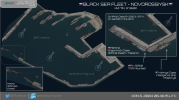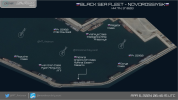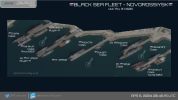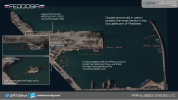Mä en tajua sitä, että miksei kehitetä kauko-ohjattavaa miinanraivauskalustoa - joo sitä on näkynyt Ukrainan maajusseilla, mutta sotilaiden käytössä ei ole näkynyt. Sen ei edes tarvitsi olla kovin kestävä, määrä ratkaisisi tässä enemmän. Vaikka miina per laitos ja uutta kalustoa tulisi niin pitkään että ura olisi valmis.Kyllä se silti parilla droonilla, tykin kranaatilla tai oikealla PST ohjuksella pysähtyy jonka jälkeen koko possujuna on taas jumissa sen yhden perässä.
Tai jos sinne tuleekin se oikea Psv vastaan kun aika kaukaa erottuu tuollainen hökötys. Lisäksi taistelukentän havainnointikin on vähintään rajoittunutta tuon kannen alla, kaiketi radiolla saa ohjeita muilta jotka näkevät jotain.
Sanoisin, että puolen tusinaa miinanraivaajavaunua olisi parempi vaihtoehto, toki jos niitä ei ole eikä tule niin joutoaikoina voi hitsata vaikka tuollaisia. Sirpale/luotisuoja mukana kulkevalle miehistölle tuo parhaassa tapauksessa on.
Install the app
How to install the app on iOS
Follow along with the video below to see how to install our site as a web app on your home screen.
Note: This feature may not be available in some browsers.
You are using an out of date browser. It may not display this or other websites correctly.
You should upgrade or use an alternative browser.
You should upgrade or use an alternative browser.
Ukrainan konflikti/sota
Sjuggen
Alikersantti
Luulisi sitä yön pimeydessä saavan miinoitettua käsipelilläkin asemien edustan, edes muutaman kymmenen metrin päähän asemista. Olettaen, ettei vastustajan asemat ole alle 100m etäisyydellä?Mä en tajua sitä, että miksei kehitetä kauko-ohjattavaa miinanraivauskalustoa - joo sitä on näkynyt Ukrainan maajusseilla, mutta sotilaiden käytössä ei ole näkynyt. Sen ei edes tarvitsi olla kovin kestävä, määrä ratkaisisi tässä enemmän. Vaikka miina per laitos ja uutta kalustoa tulisi niin pitkään että ura olisi valmis.
Voihan se olla niinkin, että noitakin kehitetään koko ajan. Ottaa vaan aikansa että saadaan kehitettyä käyttökelpoista ja valmistettua sitä riittävän paljon ja nopeasti.Mä en tajua sitä, että miksei kehitetä kauko-ohjattavaa miinanraivauskalustoa - joo sitä on näkynyt Ukrainan maajusseilla, mutta sotilaiden käytössä ei ole näkynyt. Sen ei edes tarvitsi olla kovin kestävä, määrä ratkaisisi tässä enemmän. Vaikka miina per laitos ja uutta kalustoa tulisi niin pitkään että ura olisi valmis.
tviitterissä on ollut jo useita maadroneja jotka joko pudottavat miinat paikoilleen tai vetävät sopivin välimatkoin yhteen sidottua miinaköyttä perässään. Ja hakivathan Ukrainalaiset sen megajammerikasatankinkin sieltä välimaastosta, joten eivätköhän he lisää miinojakin käy sinne sijoittelemassa.Luulisi sitä yön pimeydessä saavan miinoitettua käsipelilläkin asemien edustan, edes muutaman kymmenen metrin päähän asemista. Olettaen, ettei vastustajan asemat ole alle 100m etäisyydellä?
Nyt on mehevää, Lohtajalla olisi irronnut useampi kuntsari. Liitopommi alas Sergeillä
Siis käsittääkseni Ukrainassa tilanne on ollut se, että asevelvollisuus koskee kaikkia yli 18 vuotiaita, mutta päällä oleva liikekannallepano koskee 25 vuotiaasta ylöspäin.Tätä minä olen koko ajan ihmetellyt 18-26 miehet eivät käy armeijaa Ukrainassa, vaan se velvollisuus alkaa 27 vuotiaana.
Aiemminhan täällä on ollut 18 vuotta alaraja ja yläraja 64, Janukovytšin aikaan poistettu yleinen palvelusvelvoite.
Jossain käytiin keskustelua sen laskemisesta 25 vuoteen jatkossa ja ilmeisesti se on toteutumassa.
Kumminkin nämä 20 plus nuoret miehet olisivat parhaassa fyysisessä kunnossa ja jopa järki päässäkin ainakin joillakin iän myötä...
Esim tässä:

Ukraine wants to remove age limits for conscription into the army: what is known and what fakes are already sowing russians
Men can leave the Ukrainian army after reaching the age of 60, some - after 65. However, they want to remove these return restrictions. Read more about why parliament proposes to amend the law and what changes may await Ukrainian military personnel
As you know, during general mobilization, all citizens of Ukraine liable for military service aged 18 to 60 can be called up for military service, unless they have legal grounds for postponement or exclusion from the register. However, according to the law, the following may be granted a deferment
- reserved workers (not all professions)
- men with disabilities;
- parents with three or more minor children;
- single parents;
- parents of a child with a disability and a seriously ill child;
- parents raising an adult child with a disability of group I-II;
- guardian of a spouse, parents (own or spouse's) with a disability or serious illness;
- a guardian of an incapacitated person or a person with a disability;
- men who have a minor child if their wife is on military service.
Toki asepalveluksen suorittamista rauhan aikana on kaikenlaisilla verukkeilla voinut välttää.
Edit:
Otetaan vielä kotimaan esimerkki. Ei meilläkään liikekannallepano koske välittömästi kaikkia asevelvollisia, vaan pillin puhaltaessa niitä 280 000 ensilähtöön määrättyä.
Mikä ongelma? Ihmisen fyysinen suorituskyky on 26v parempi mitä 20 vuotiaana henkisestä nyt puhumattakaan.
Aliresurssoidun pienemmän puolustajan ei ole kovin viisasta jättää seitsemää parhaassa iässä olevaa ikäluokkaa sotimisen ulkopuolelle.
Tai jos kannattaa, tehdään tämä kaikkialla muualla väärin, Suomessakin.
rty19
Greatest Leader
lsoviha
Eversti
Valtava maantiesilta on romahtanut Venäjällä – junaliikenne Moskovasta Smolenskiin poikki, alueellinen kaasuputki puhki

 www.is.fi
www.is.fi
Voi olla että ei liity sotaan, mutta "yllättäen romahti kuusi jänneväliä seitsemästä" ja sopivassa kohdassa.

Valtava maantiesilta on romahtanut Venäjällä – junaliikenne Moskovasta Smolenskiin poikki, alueellinen kaasuputki puhki
Suuri maantiesilta on pudonnut moniraiteisen Moskova-Smolensk -päärautatielinjan päälle.
Voi olla että ei liity sotaan, mutta "yllättäen romahti kuusi jänneväliä seitsemästä" ja sopivassa kohdassa.
Viimeksi muokattu:
Hanski
Respected Leader
Kovin ikävää...Valtava maantiesilta on romahtanut Venäjällä – junaliikenne Moskovasta Smolenskiin poikki, alueellinen kaasuputki puhki

Valtava maantiesilta on romahtanut Venäjällä – junaliikenne Moskovasta Smolenskiin poikki, alueellinen kaasuputki puhki
Suuri maantiesilta on pudonnut moniraiteisen Moskova-Smolensk -päärautatielinjan päälle.www.is.fi
tulikomento
Supreme Leader
Valtava maantiesilta on romahtanut Venäjällä – junaliikenne Moskovasta Smolenskiin poikki, alueellinen kaasuputki puhki

Valtava maantiesilta on romahtanut Venäjällä – junaliikenne Moskovasta Smolenskiin poikki, alueellinen kaasuputki puhki
Suuri maantiesilta on pudonnut moniraiteisen Moskova-Smolensk -päärautatielinjan päälle.www.is.fi
Toivottavasti lahoaa niillä käsiin koko kusisen ankea maa.
Antares
Respected Leader
Luulisi purevan jos osuu kun P-15 ohjuksen kärki latinkina
Lainaan artikkelin tekstin spoilerin taakse:
https://www.navalnews.com/naval-new...is-american-boat-with-massive-soviet-warhead/
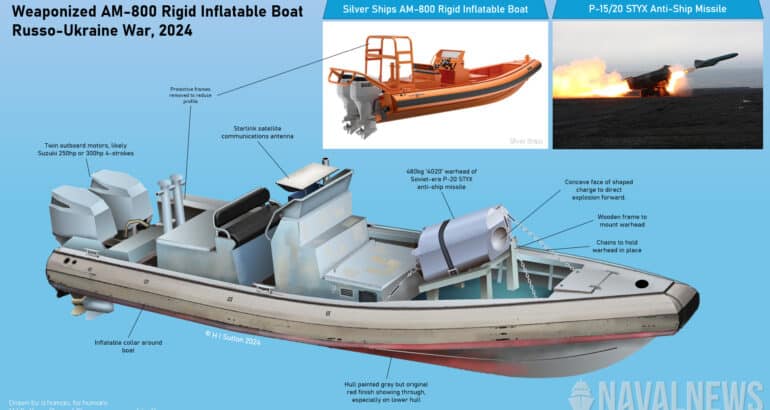
Click to enlarge. The new USV is evidently a converted AM-800 rigid inflatable boat (RIB). It is armed with a massive warhead from a Soviet-era Styx anti-ship missile.
An unusual maritime drone was discovered floating upside down in Romanian waters on April 3 2024. The new type of uncrewed surface vessel (USV) was actually based on an American built rescue boat, modified as a drone. It was equipped with a large warhead indicating that it was designed to hit ships or other naval targets.
Romanian forces reportedly destroyed the boat in a controlled explosion on April 5. The events were not publicized initially and few details were revealed when it was later shared in local media. However an analysis of the vessel answers the questions of what it is, yet raises new questions.
The USV uses an AM-800 aluminum-hull rigid inflatable boat (RIB). This is produced by Silver Ships in Alabama, United States. The boat is designed for fire rescue and the original red finish is still visible on the lower hull and inflatable collar.
The AM-800 is around 9.5 meters (31 feet) long including the outboard motors. While still small, this makes it nearly twice the length of the Magura and Sea Baby USVs Ukraine is using. The RIB is likely to be seen from further away. Its powerful warhead may make up for this.
The warhead is mounted on a crude wooden frame in the forward deck of the boat. It is a ‘4G20′ model which is associated with P-20 export model variants of the Styx missile. It weighs just under 500kg (1,100lb) of TGAG-5 explosives which is 60% TNT, 20% RDX, 15% aluminum powder and 5% phlegmatizing wax. For context, this is over twice the size of the Harpoon anti-ship missiles’ warhead.
Interestingly, the Houthi Movement has also used this type of warhead on some of its explosive USVs. The Houthi’s had access to these warheads from legacy Yemeni Navy stocks so there is no suggestion of a direct link to this new vessel.
The warhead has a shaped charge at the front to punch a large hole in the ship before the main charge detonates, thus causing more damage. This is described as a high-explosive-cumulative charge. In the missile the shaped charge is facing slightly downwards to cause maximum damage. On the USV however it is desirable to direct the shaped charge directly forward, so the whole warhead has been mounted at an angle. While the stand-off detonation from the USV is less desirable than the penetrating hit of the missile, the size of the warhead makes this USV formidable.
However the possibility that it could be Russian should be seriously considered. Russia has tried to disrupt or prevent merchant ships sailing to Ukraine since the end of the Black Sea Grain Initiative last July. Efforts have focused on attacking Ukrainian port infrastructure, but air-dropped mines have also been used. This is likely because mines are more deniable than using warships or missiles.
However the mines have been unsuccessful so far, with some Ukrainian sources suggesting that the Russians are now unable to sow them. Therefore Russia may be tempted to use USVs to hit ships, thus reestablishing a de facto blockade. Although it may be clear which country is doing it, the USVs would still be deniable. It is likely that Russian propaganda would blame Ukraine to create enough ambiguity to avoid immediate consequences.
Whether this USV was Ukrainian (which seems most likely) or Russian may be revealed in due course. But the likelihood of both sides operating USVs in the Black Sea is increasing so a Russian craft is bound to turn up sooner or later.
-
Posted by : H I Sutton
H I Sutton writes about the secretive and under-reported submarines, seeking out unusual and interesting vessels and technologies involved in fighting beneath the waves. Submarines, capabilities, naval special forces underwater vehicles and the changing world of underwater warfare and seabed warfare. To do this he combines the latest Open Source Intelligence (OSINT) with the traditional art and science of defense analysis. He occasionally writes non-fiction books on these topics and draws analysis-based illustrations to bring the subject to life. In addition, H I Sutton is a naval history buff and data geek. His personal website about these topics is Covert Shores (www.hisutton.com)

Click to enlarge. The new USV is evidently a converted AM-800 rigid inflatable boat (RIB). It is armed with a massive warhead from a Soviet-era Styx anti-ship missile.
Sea Drone Found In Black Sea Is American Boat With Massive Soviet Warhead
A mysterious maritime drone (USV) has been discovered in the Black Sea. The capsized vessel marries a U.S. built hull with a Soviet-era Russian warhead. At around 500 kg (1,100 lb), the warhead is more than twice the size of that on a Harpoon or Neptune missile.
H I Sutton 08 Apr 2024An unusual maritime drone was discovered floating upside down in Romanian waters on April 3 2024. The new type of uncrewed surface vessel (USV) was actually based on an American built rescue boat, modified as a drone. It was equipped with a large warhead indicating that it was designed to hit ships or other naval targets.
Romanian forces reportedly destroyed the boat in a controlled explosion on April 5. The events were not publicized initially and few details were revealed when it was later shared in local media. However an analysis of the vessel answers the questions of what it is, yet raises new questions.
The USV uses an AM-800 aluminum-hull rigid inflatable boat (RIB). This is produced by Silver Ships in Alabama, United States. The boat is designed for fire rescue and the original red finish is still visible on the lower hull and inflatable collar.
The AM-800 is around 9.5 meters (31 feet) long including the outboard motors. While still small, this makes it nearly twice the length of the Magura and Sea Baby USVs Ukraine is using. The RIB is likely to be seen from further away. Its powerful warhead may make up for this.
Powerful warhead from Styx missile
The warhead is from a P-20 Styx anti-ship missile. This is a Soviet-era weapon and, while still in service in Russia, is generally viewed as obsolete. It has a noticeably powerful warhead though, it’s main merit. Both Russia and Ukraine likely have easy access to this type of warhead.The warhead is mounted on a crude wooden frame in the forward deck of the boat. It is a ‘4G20′ model which is associated with P-20 export model variants of the Styx missile. It weighs just under 500kg (1,100lb) of TGAG-5 explosives which is 60% TNT, 20% RDX, 15% aluminum powder and 5% phlegmatizing wax. For context, this is over twice the size of the Harpoon anti-ship missiles’ warhead.
Interestingly, the Houthi Movement has also used this type of warhead on some of its explosive USVs. The Houthi’s had access to these warheads from legacy Yemeni Navy stocks so there is no suggestion of a direct link to this new vessel.
The warhead has a shaped charge at the front to punch a large hole in the ship before the main charge detonates, thus causing more damage. This is described as a high-explosive-cumulative charge. In the missile the shaped charge is facing slightly downwards to cause maximum damage. On the USV however it is desirable to direct the shaped charge directly forward, so the whole warhead has been mounted at an angle. While the stand-off detonation from the USV is less desirable than the penetrating hit of the missile, the size of the warhead makes this USV formidable.
Attribution: Whose is it?
The nationality of the vessel was not shared officially, although some local media suggested that it is Ukrainian. The nature of the vessel, and being based on an American hull, does support this conclusion. The manufacturer, Silver Ships, had previously been reportedly supplying unspecified craft to Ukraine as part of U.S. Aid. So it seems most straightforward that it is Ukrainian. It possibly capsized further north and drifted to where it was found.However the possibility that it could be Russian should be seriously considered. Russia has tried to disrupt or prevent merchant ships sailing to Ukraine since the end of the Black Sea Grain Initiative last July. Efforts have focused on attacking Ukrainian port infrastructure, but air-dropped mines have also been used. This is likely because mines are more deniable than using warships or missiles.
However the mines have been unsuccessful so far, with some Ukrainian sources suggesting that the Russians are now unable to sow them. Therefore Russia may be tempted to use USVs to hit ships, thus reestablishing a de facto blockade. Although it may be clear which country is doing it, the USVs would still be deniable. It is likely that Russian propaganda would blame Ukraine to create enough ambiguity to avoid immediate consequences.
Whether this USV was Ukrainian (which seems most likely) or Russian may be revealed in due course. But the likelihood of both sides operating USVs in the Black Sea is increasing so a Russian craft is bound to turn up sooner or later.
-
Posted by : H I Sutton
H I Sutton writes about the secretive and under-reported submarines, seeking out unusual and interesting vessels and technologies involved in fighting beneath the waves. Submarines, capabilities, naval special forces underwater vehicles and the changing world of underwater warfare and seabed warfare. To do this he combines the latest Open Source Intelligence (OSINT) with the traditional art and science of defense analysis. He occasionally writes non-fiction books on these topics and draws analysis-based illustrations to bring the subject to life. In addition, H I Sutton is a naval history buff and data geek. His personal website about these topics is Covert Shores (www.hisutton.com)
-
On siinä taistelukärjellä kokoa, yli 500kg.
Kuten artikkelissa todetaan, ei ole todisteita, onko meridrone venäläistä vai ukrainalaista alkuperää. JOS minun pitäisi veikata, arvaisin että ukrainalainen.
Taistelukärjessä sanotaan olevan ontelopanos joka iskee ensin reiän ja sen jälkeen räjäytetään varsinainen räjähdelasti.
Tällainen sopisi tietysti sotalaivojen upottamiseen mutta minä mietin että tällainen voisi purra hyvin Kerchin sillan tukipilareihin. Muistan että tässä ketjussakin on pohdittu vastaavanlaista viristystä ja sellaisen purevuutta: isketään pilareihin reiät ontelopanoksella tai suurella EFP-panoksella (tehdään siis alkureikä / alkusärö) ja sen jälkeen varsinaisilla räjähteillä, jotka toivottavasti rikkovat pilareita lisää.
Teräsbetonipilarit ovat vahvoja, joten tiedä sitten millaista jälkeä tuolla saisi mutta eivät ne 500kg taistelukärjen räjäyttämisestä ainakaan paremmiksi tule.
Toisaalta voisi kuvitella että sillan pilareita eli kantavia rakenteita vastaan purisi paremmin sellainen taistelukärki jonka saisi upotettua veden alle sen pilarin vieressä. Silloin räjähdysvoima ei karkaa niin suuresti ilmaan, vaikka toki leviää eri suuntaan veden alla räjähtäessäkin. Jonkinlainen torpedo / syvällä uiva itsemurhadrone tai kenties uppoava miina voisi olla kokeilemisen arvoinen idea.
Antares
Respected Leader
Katso liite: 96302
Ukrainalaiset tuhonneet "ladoga" ABC-tuomionpäivävaunun Kreminnan lähistöllä. Näitä valmistettiin T-80 alustalle 4 + 1 testivaunu yli 40 vuotta sitten. Vaunulla voidaan operoida ydinlaskeumassa, kemiallisessa hyökkäyksessä ja biologisessa iskussa.
Katso liite: 96316
Vaunulla oli tarkoitus kuljettaa vip henkilöitä pois moskovasta ydiniskun jälkeen. Reittisuunnitelma oli kremlin kellarista lähimmälle toimivalle sotilaslentokentälle. Vaunu on ennenkin rullannut Ukrainassa, koska kahta näistä käytettiin chernobylin siivousoperaatiossa reaktorihallin ulkopuolella ja lähialueilla mm. säteilymittauksiin ja kuvaamiseen
Aika vähissä on vaunut kun museoidut prototyypit on tuotu rintamalle. Perässä köydet eli varmaan hinausvaununa käytetty kun aseistusta ei ole.
mukavaa menoa, kuskin ja johtajan lisäksi 4 hlö matkustamo väri-tv:llä, kokolattiamatolla, baarikaapilla ja nahkajakkaroilla. Tankkiluukkujen sijaan kyljestä kääntyvät helikopteriportaat ulos, ettei pukuun tule rasvatahroja.
Katso liite: 96314
Vaunun historia on mielenkiintoista luettavaa, ladogan osuus alkaa sivun puolivälissä.

Ukraine appears to have destroyed a rare Soviet-era 'doomsday' armored vehicle that was first used at Chernobyl
The Ladoga was originally intended to be a means of transport for senior Kremlin officials in the event of a nuclear attack.www.businessinsider.com
Samat sävelet Ukrainassa nähtyjen BTR-90 vaunujen osalta: vähälukuisia nekin, ei juuri esisarjaa enempää.
Silti niitäkin otettu käyttöön eli selvästi revitään kaikki vähänkin liikehtimiskykyiset vaunut Ukrainaan, soveltuivatpa tarpeeseen tai eivät.
Kertoo mielestäni siitä että on asetettu kiintiöt vaunujen määrälle ja ei ole paljoa kyselty, miten ne täytetään (kunhan täytetään). Koska kiintiöiden täyttäminen ei onnistu pelkällä uustuotannolla ja varastotukikohdista aktivoiduilla ja modernisoiduilla, on otettu kaikki mahdolliset vaihtoehdot käyttöön, mukaanlukien nämä harvalukuiset prototyypit ja esisarjojen verran valmistetut.
Antares
Respected Leader
Oryx linjasi aikaisemmin etteivät tule laskemaan Desertcross 4x4 ATV / golfkärryjä eivät Buchanka pakettiautojakaan (poistivat ne listoiltaan), joten hyvä että joku vaivautuu laskemaan todennetut Desertcross tappiot:
Four wheeler/ATV/golf cart visually confirmed RU losses by month:
Sep 2023: 2
Dec 2023: 6
Jan 2024: 5
Feb 2024: 23 (0.8/day)
Mar 2024: 94 (3.0/day)
Apr 2024 (so far): 15 (1.9/day)
-
Yllä olevan listan summa = 145 kpl
Toki tässä ovat vain todistetut menetykset, todellinen määrä voi olla suurempi tai jopa selvästi suurempi (tätä ei voida tietää).
Voidaan myös laskea karkea arvio huhtikuun 2024 määräksi (jos tappiot jatkuvat samassa suhteessa):
15 / 9 x 30 = 50
Muistin virkistämiseksi: ryssän kerrottiin tilanneen 2 100 kpl näitä Desertcross 4x4 ATV ajoneuvoja, joista olisi toimitettu 537 kpl artikkelin julkaisun hetkellä / aikoihin eli 10.11.2023. Lisäksi artikkelin mukaan sopimuksen mukaan oli määrä toimittaa 500 kpl lisää "joulukuussa 2024" ja viimeiset 1 090 kpl "vuoden 2024 ensimmäisellä neljänneksellä" eli kolmen ensimmäisen kuukauden aikana. LÄHDE
Täten jos artikkelin tiedot pitivät paikkansa ja siinä kerrottu sopimus olisi toteutunut sovitulla tavalla, niin silloin koko tilattu määrä olisi pitänyt olla toimitettuna 31.3.2024 mennessä eli reilu viikko sitten.
Ovatko allekirjoittaneet uuden sopimuksen vai tuumivatko että nämä riittävät hetkeksi?
Four wheeler/ATV/golf cart visually confirmed RU losses by month:
Sep 2023: 2
Dec 2023: 6
Jan 2024: 5
Feb 2024: 23 (0.8/day)
Mar 2024: 94 (3.0/day)
Apr 2024 (so far): 15 (1.9/day)
-
Yllä olevan listan summa = 145 kpl
Toki tässä ovat vain todistetut menetykset, todellinen määrä voi olla suurempi tai jopa selvästi suurempi (tätä ei voida tietää).
Voidaan myös laskea karkea arvio huhtikuun 2024 määräksi (jos tappiot jatkuvat samassa suhteessa):
15 / 9 x 30 = 50
Muistin virkistämiseksi: ryssän kerrottiin tilanneen 2 100 kpl näitä Desertcross 4x4 ATV ajoneuvoja, joista olisi toimitettu 537 kpl artikkelin julkaisun hetkellä / aikoihin eli 10.11.2023. Lisäksi artikkelin mukaan sopimuksen mukaan oli määrä toimittaa 500 kpl lisää "joulukuussa 2024" ja viimeiset 1 090 kpl "vuoden 2024 ensimmäisellä neljänneksellä" eli kolmen ensimmäisen kuukauden aikana. LÄHDE
Täten jos artikkelin tiedot pitivät paikkansa ja siinä kerrottu sopimus olisi toteutunut sovitulla tavalla, niin silloin koko tilattu määrä olisi pitänyt olla toimitettuna 31.3.2024 mennessä eli reilu viikko sitten.
Ovatko allekirjoittaneet uuden sopimuksen vai tuumivatko että nämä riittävät hetkeksi?
Antares
Respected Leader
MT Anderson tarjoaa tuoreet satelliittikuvat Novorossiyskin satamasta:
BLACK SEA FLEET
0.5m pictures (6 April 2024) of Novorossiysk, Feodosia & Sevastopol.
Good view of where Russian Navy are positioning their vessels
Novorossiysk: primary warships, subs & assault ships
Sevastopol: small missiles boats, AS ships, Minesweepers
Feodosia: nothing
-
Tätä aikaisempi katsaus oli 19.3.2024 ja sen teksti sekä kuvat löytyvät tästä viestistä: LINKKI
BLACK SEA FLEET
0.5m pictures (6 April 2024) of Novorossiysk, Feodosia & Sevastopol.
Good view of where Russian Navy are positioning their vessels
Novorossiysk: primary warships, subs & assault ships
Sevastopol: small missiles boats, AS ships, Minesweepers
Feodosia: nothing
-
Tätä aikaisempi katsaus oli 19.3.2024 ja sen teksti sekä kuvat löytyvät tästä viestistä: LINKKI
taantumu
Ylipäällikkö
Ulkomaantiedustelu SVR:n mukaan USA värvää vankiloistaan meksikolaisia ja kolumbialaisia huumekartellien jäseniä sotimaan Ukrainaan, ensimmäisen erän kerrotaan saapuvan kesällä.
Toisena huumoriuutsena Venäjä aloittaa tutkimukset terrorismin rahoittamisesta USA:n ja NATO:n toimesta.
https://tass.ru/politika/20492849The SVR stated that Mexicans and Colombians are being recruited in US prisons to be sent to Ukraine
MOSCOW, April 9. /TASS/. American PMCs, with the participation of the authorities, are recruiting representatives of Mexican and Colombian drug cartels in US prisons to be sent to the ranks of the Armed Forces of Ukraine (AFU). This was announced to TASS by the press bureau of the Foreign Intelligence Service (SVR) of the Russian Federation.
“The United States is resorting to increasingly desperate methods in its attempts to turn the tide in the Ukrainian theater of operations, replenishing the ranks of demoralized Ukrainian Armed Forces fighters with a multinational rabble with a penchant for armed violence. According to data received by the Russian Foreign Intelligence Service, for these purposes, American PMCs under the leadership of the Directorate for Combating with drugs and the US FBI began to recruit representatives of Mexican and Colombian drug cartels serving sentences in American prisons to participate in the Ukrainian conflict on the side of the degrading Kyiv regime,” the press bureau noted.
The SVR reported that if they agree to such a “business trip,” the prisoners are promised a complete amnesty “in the expectation that they will never return back.” “The first batch of thugs is planned to be sent to the combat zone in the summer. The gang will consist of several hundred Mexicans and Colombians,” the press bureau informed. “If the pilot project to replenish the ranks of the Armed Forces of Ukraine with Latin American criminals succeeds, then the program for recruiting flayers will be continued and even expanded at the expense of criminals from other countries that have a difficult crime situation."
At the same time, according to the SVR, the process is “not without problems.” “Negotiations with drug lords are going hard, without whose blessing not a single bandit would dare to cooperate with the American authorities, fearing for his life and that of his loved ones. Gang leaders are trying to sell their thugs at a higher price, jeopardizing the fulfillment of the American plan,” the press bureau explained .
“Of course, the prospect of another influx of foreign “soldiers of fortune” from among serial killers, drug addicts and rapists into the long-suffering lands of the Russian World is alarming. However, the Americans’ plans to gain a tactical advantage on the battlefield in this way are doomed to failure. The administration of [US President] Joe Biden in fact, she admits her impotence and once again demonstrates to us the inconsistency of the Kyiv regime she is feeding,” the press bureau of the Foreign Intelligence Service summarized.
Toisena huumoriuutsena Venäjä aloittaa tutkimukset terrorismin rahoittamisesta USA:n ja NATO:n toimesta.
https://tass.ru/proisshestviya/20492075The Investigative Committee opened a case on the financing of terrorism by officials of the United States and NATO countries
MOSCOW, April 9. /TASS/. The Russian Investigative Committee opened a criminal case in connection with an appeal from State Duma deputies about the financing of terrorism by the United States and other Western countries. The department's press service reported this to TASS.
“The main investigative department of the Investigative Committee of Russia conducted an inspection following an appeal from a group of State Duma deputies and other persons about the financing of terrorist activities by senior officials of the United States and NATO countries. Based on its results, a criminal case was opened on the grounds of a crime under Part 4 of Article 205.1 of the Criminal Code of the Russian Federation (financing terrorism)," the message says.
Investigators have established that funds received through commercial organizations, in particular, the oil and gas company Burisma Holdings, operating in Ukraine, have been used in recent years to carry out terrorist acts in Russia, as well as abroad, in order to eliminate prominent political and public figures and causing economic damage. “The investigation, in cooperation with other intelligence services and financial intelligence, is checking the sources of income and further movement of funds in the amount of several million US dollars, the involvement of specific individuals from among government officials, public and commercial organizations of Western countries. In addition, connections are being worked out through investigative and operational means direct perpetrators of terrorist acts with foreign curators, organizers and sponsors,” the message says.
Earlier, the Investigative Committee began an investigation into the appeal of deputies about the organization of terrorist attacks in Russia by the United States and other Western countries. The department noted that as part of the investigation, the investigation will carefully study the data presented. In addition, the General Prosecutor's Office also noted that the department will study materials received from State Duma deputies about the organization and financing of a number of terrorist attacks on the territory of the Russian Federation, as well as the undermining of the Nord Stream 1 and Nord Stream 2 gas pipelines by persons and organizations located in USA, Germany, France and Cyprus. The department noted that the materials will be carefully studied, after which the issue of using mechanisms of international legal cooperation will be considered.
On September 27, 2023, Nord Stream AG reported “unprecedented destruction” that occurred the day before “on three strings of the Nord Stream and Nord Stream 2 offshore gas pipelines.” Swedish seismologists recorded two explosions on September 26 on offshore pipeline routes. Prosecutor General’s Office The Russian Federation initiated the initiation of a case for an act of international terrorism after damage to gas pipelines.
Antares
Respected Leader
Laadin aikaisemmin MT Andersonin 19.3.2024 julkaistujen satelliittikuvien perusteella seuraavan listan Novorossiyskin satamassa ko. päivänä olleista aluksista:
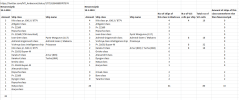
Taulukon oikean reunan laskelma "muualla olevista aluksista" perustuu usein nähtyyn kuvaan ryssän Mustallamerellä olevista sotalaivoista. HUOM: kyseisestä kuvasta puuttuvat "pienet partioveneet yms." eli se sisältää ainoastaan merkittävämmät sotalaivat ja sukellusveneet. Täten ei pidä kuvitella että minun laskelmani sisältäisi "jokaisen sotalaivan" vaan ainoastaan ne merkittävämmät eli suuremmat.
Lisäksi hyvä tiedostaa että minun VLS-solujen laskelma on tehty laiskasti eli siinä on haettu eri alusluokkien VLS-solujen määrä per alus wikipediasta eli käyty lukemassa eri alusten artikkeleita ja poimittu sieltä numero. Sen jälkeen on laskettu alusten määrä kertaa ko. numero, jotta saadaan "VLS-solujen määrä yhteensä". Virheen mahdollisuus on siis ilmeinen: kenties tietyissä Mustallamerellä olevissa aluksissa onkin vähemmän soluja kuin mitä kyseisen alusluokan wikipedia-artikkeli sanoo?
-
Tässä sama taulukko mutta päivitettynä 6.4.2024 otettujen kuvien mukaisesti (lähde edellisen viestin data: LINKKI):

Hyvin pitkälti samat alukset olivat Novorossiyskin satamassa 19.3.2024 ja 6.4.2024.
Ainoat erot näiden kuvien välillä:
- 6.4.2024 on 1 kpl Kilo-luokan sukellusvene vähemmän kuin 19.3.2024
- 6.4.2024 on 1 kpl Ropucha-luokan maihinnousualuksia enemmän kuin 19.3.2024
- 6.4.2024 on 1 kpl Pr. 21631 Buyan-M luokan aluksia enemmän kuin 19.3.2024
Eli näiden takia 6.4.2024 Novorossiyskin satamassa oli 27 kpl erilaisia sota-aluksia, kun taas 19.3.2024 aluksia oli 26 kpl.
JOS laskelmani pitää paikkansa, niin ryssällä oli 14 kpl Mustallemerelle sijoitettuja sota-aluksia "jossain muualla" kuin Novorossiyskin satamassa 6.4.2024. Kiehtovasti molempina päivinä satamassa ei ollut yhtään Krivak-, Bora- tai Tarantul-luokan aluksia, joita on Mustallamerellä yhteensä 6 kpl. Samoin molempina päivinä "jossain muualla" oli 1 kpl Natya-luokan aluksia, 5 kpl Grisha-luokan aluksia ja 1 kpl Alligator-luokan aluksia.
Kilo-luokan sukellusveneiden ja Ropucha-luokan maihinnousualusten määrä on eri näiden kahden päivien laskelmissa, mikä kertoo siitä että kyseisen luokan aluksia (tai ainakin osaa niistä) käytetään. Toki kahtena päivänä otetut satelliittikuvat muodostavat pienen määrän dataan joten voi myös olla sattumaa että suunnilleen sama määrä samoja alustyyppejä kelluu ko. satamassa kuvien ottamisen aikaan. Pidän silti uskottavampana että valtaosa ryssän sota-aluksista on komennettuna satamaan, jotta vältytään tarpeettomilta riskeiltä ja tappioilta.
-
HUOM: Karakurt-luokan alusten määrä Mustallamerellä on hieman epäselvä. MT Andersonin mukaan yksi Karakurt-luokan aluksista nimeltään Askold (802) olisi korjattavana (tai ainakin oli korjattavana vielä 30.1.2024): LÄHDE
She is/was at the Zaliv Shipyard in Kerch, as of 30 Jan 2024
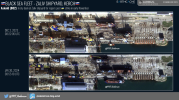
-
MUOKKAUS: MT Anderson on myös julkaissut 1.4.2024 otetut satelliittikuvat Novorossiyskin satamasta (LÄHDE), tässä niiden perusteella päivitetty taulukko:

Eri alustyyppien määrät näyttävät olevan täsmälleen samat 19.3.2024 ja 1.4.2024 otetuissa kuvissa, joten 6.4.2024 otettujen kuvien erot ovat samat myös 1.4.2024 verrattuna.
1.4.2024 julkaistuun viestiin tulleessa vastauksessa tunnistettiin Dyogon-luokan alus: LÄHDE
Dyugon class landing craft has to be Ataman Platov from Caspian Flotilla.
-
Lisäksi 1.4.2024 julkaistuun viestiin oli kommentoitu näin (eli kuvassa lastataan Kalibr-risteilyohjuksia jompaan kumpaan Admiral Grigorovich -luokan alukseen, joko Admiral Essen tai Admiral Makarov): LÄHDE ja LÄHDE 2
Ukrainian researchers have noticed in your pictures the loading of Kalibr missiles.
Ракеты = Rockets
https://t.me/Crimeanwind/56750
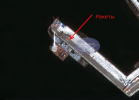

Taulukon oikean reunan laskelma "muualla olevista aluksista" perustuu usein nähtyyn kuvaan ryssän Mustallamerellä olevista sotalaivoista. HUOM: kyseisestä kuvasta puuttuvat "pienet partioveneet yms." eli se sisältää ainoastaan merkittävämmät sotalaivat ja sukellusveneet. Täten ei pidä kuvitella että minun laskelmani sisältäisi "jokaisen sotalaivan" vaan ainoastaan ne merkittävämmät eli suuremmat.
Lisäksi hyvä tiedostaa että minun VLS-solujen laskelma on tehty laiskasti eli siinä on haettu eri alusluokkien VLS-solujen määrä per alus wikipediasta eli käyty lukemassa eri alusten artikkeleita ja poimittu sieltä numero. Sen jälkeen on laskettu alusten määrä kertaa ko. numero, jotta saadaan "VLS-solujen määrä yhteensä". Virheen mahdollisuus on siis ilmeinen: kenties tietyissä Mustallamerellä olevissa aluksissa onkin vähemmän soluja kuin mitä kyseisen alusluokan wikipedia-artikkeli sanoo?
-
Tässä sama taulukko mutta päivitettynä 6.4.2024 otettujen kuvien mukaisesti (lähde edellisen viestin data: LINKKI):

Hyvin pitkälti samat alukset olivat Novorossiyskin satamassa 19.3.2024 ja 6.4.2024.
Ainoat erot näiden kuvien välillä:
- 6.4.2024 on 1 kpl Kilo-luokan sukellusvene vähemmän kuin 19.3.2024
- 6.4.2024 on 1 kpl Ropucha-luokan maihinnousualuksia enemmän kuin 19.3.2024
- 6.4.2024 on 1 kpl Pr. 21631 Buyan-M luokan aluksia enemmän kuin 19.3.2024
Eli näiden takia 6.4.2024 Novorossiyskin satamassa oli 27 kpl erilaisia sota-aluksia, kun taas 19.3.2024 aluksia oli 26 kpl.
JOS laskelmani pitää paikkansa, niin ryssällä oli 14 kpl Mustallemerelle sijoitettuja sota-aluksia "jossain muualla" kuin Novorossiyskin satamassa 6.4.2024. Kiehtovasti molempina päivinä satamassa ei ollut yhtään Krivak-, Bora- tai Tarantul-luokan aluksia, joita on Mustallamerellä yhteensä 6 kpl. Samoin molempina päivinä "jossain muualla" oli 1 kpl Natya-luokan aluksia, 5 kpl Grisha-luokan aluksia ja 1 kpl Alligator-luokan aluksia.
Kilo-luokan sukellusveneiden ja Ropucha-luokan maihinnousualusten määrä on eri näiden kahden päivien laskelmissa, mikä kertoo siitä että kyseisen luokan aluksia (tai ainakin osaa niistä) käytetään. Toki kahtena päivänä otetut satelliittikuvat muodostavat pienen määrän dataan joten voi myös olla sattumaa että suunnilleen sama määrä samoja alustyyppejä kelluu ko. satamassa kuvien ottamisen aikaan. Pidän silti uskottavampana että valtaosa ryssän sota-aluksista on komennettuna satamaan, jotta vältytään tarpeettomilta riskeiltä ja tappioilta.
-
HUOM: Karakurt-luokan alusten määrä Mustallamerellä on hieman epäselvä. MT Andersonin mukaan yksi Karakurt-luokan aluksista nimeltään Askold (802) olisi korjattavana (tai ainakin oli korjattavana vielä 30.1.2024): LÄHDE
She is/was at the Zaliv Shipyard in Kerch, as of 30 Jan 2024

-
MUOKKAUS: MT Anderson on myös julkaissut 1.4.2024 otetut satelliittikuvat Novorossiyskin satamasta (LÄHDE), tässä niiden perusteella päivitetty taulukko:

Eri alustyyppien määrät näyttävät olevan täsmälleen samat 19.3.2024 ja 1.4.2024 otetuissa kuvissa, joten 6.4.2024 otettujen kuvien erot ovat samat myös 1.4.2024 verrattuna.
1.4.2024 julkaistuun viestiin tulleessa vastauksessa tunnistettiin Dyogon-luokan alus: LÄHDE
Dyugon class landing craft has to be Ataman Platov from Caspian Flotilla.
-
Lisäksi 1.4.2024 julkaistuun viestiin oli kommentoitu näin (eli kuvassa lastataan Kalibr-risteilyohjuksia jompaan kumpaan Admiral Grigorovich -luokan alukseen, joko Admiral Essen tai Admiral Makarov): LÄHDE ja LÄHDE 2
Ukrainian researchers have noticed in your pictures the loading of Kalibr missiles.
Ракеты = Rockets
https://t.me/Crimeanwind/56750
Judging by satellite images, Russia has the opportunity to charge missiles directly in the port of Novorossiysk , reports the Crimean Wind monitoring group.
Previously, this was only possible in Sevastopol, which is why carriers of Caliber cruise missiles were forced to regularly enter bays that the Ukrainian Armed Forces could strike.
It sucks, but it’s okay, we’ll get there.
t.me/Crimeanwind/56750
47.9Kviewsedited
Apr 2 at 16:59
Previously, this was only possible in Sevastopol, which is why carriers of Caliber cruise missiles were forced to regularly enter bays that the Ukrainian Armed Forces could strike.
It sucks, but it’s okay, we’ll get there.
t.me/Crimeanwind/56750
47.9Kviewsedited
Apr 2 at 16:59

Viimeksi muokattu:
lsoviha
Eversti
"Alkujaan supisuomalaisesta Teboil-brändistä on tullut yksi sotaa käyvän Venäjän näkyvimmistä urheilusponsoreista."

 www.is.fi
www.is.fi

 www.is.fi
www.is.fi
Onko löytynyt pakotteista porsaanreikä markkinoinnin ja sponsoroinnin osalta?
Teboil siirtää rahat venäjälle ja jättää verot maksamatta suomeen kun voi vähentää kuluina?
Trustivapaaseen bensiiniin ei ole koskaan ollut luottoa

Teboil ryhtyi rahoittamaan urheilutapahtumaa Irkutskissa – kuva paljastaa toisenkin erikoisen ”suomalaisbrändin”
Teboilin ja Ikon Tyresin logot loistavat nyt Venäjällä rintarinnan. Kumpikin brändeistä on saman näyttävän venäläisen autourheilutapahtuman merkittävä sponsori.

Teboil ryhtyi Venäjän hiihtokiertueen sponsoriksi
Teboil on näkyvästi esillä venäläisissä hiihtokisoissa.
Onko löytynyt pakotteista porsaanreikä markkinoinnin ja sponsoroinnin osalta?
Teboil siirtää rahat venäjälle ja jättää verot maksamatta suomeen kun voi vähentää kuluina?
Trustivapaaseen bensiiniin ei ole koskaan ollut luottoa
Viimeksi muokattu:
Isoalaviiva
Eversti
X:ssä kiertää video, missä ryssä (väitetysti) leikkaa toisen ryssän käden irti, ettei tarvi osallistua hyökkäykseen...
Ihme motivaatio-ongelmia niilläkin
Ihme motivaatio-ongelmia niilläkin
Mutta, muistakaa silti: paikallinen yrittäjä jolla ei ole mitään tekemistä putinin sodan kanssa. Ja veripihvit lähimmällä teboililla..Alkujaan supisuomalaisesta Teboil-brändistä on tullut yksi sotaa käyvän Venäjän näkyvimmistä urheilusponsoreista.

Teboil ryhtyi rahoittamaan urheilutapahtumaa Irkutskissa – kuva paljastaa toisenkin erikoisen ”suomalaisbrändin”
Teboilin ja Ikon Tyresin logot loistavat nyt Venäjällä rintarinnan. Kumpikin brändeistä on saman näyttävän venäläisen autourheilutapahtuman merkittävä sponsori.www.is.fi

Teboil ryhtyi Venäjän hiihtokiertueen sponsoriksi
Teboil on näkyvästi esillä venäläisissä hiihtokisoissa.www.is.fi
Onko löytynyt pakotteista porsaanreikä markkinoinnin ja sponsoroinnin osalta?
Teboil siirtää rahat venäjälle ja jättää verot maksamatta suomeen kun voi vähentää kuluina?
Trustivapaaseen bensiiniin ei ole koskaan ollut luottoa
Tästä vähän vauhtia. IT- infra tuhottu tämän mukaan. Hukkukaa paskaan.Toivottavasti lahoaa niillä käsiin koko kusisen ankea maa.
Reports have appeared that Ukrainian hackers destroyed Moscollector (Moscow sewage company) IT infrastructure.Moscollector company is responsible for the operation of underground water pipes, communication cables, power cables, and heating networks in Moscow. Ukrainian hackers reportedly turned off 87,000 sensors of various warning systems throughout Moscow and the Moscow region. In addition, 70 servers and at least 90 terabytes of company data (e-mails, backups, contracts) were destroyed.According to sources, it might have been an operation by the BLACKJACK hacker group. Now, the operation of a critical infrastructure facility in Moscow is completely blocked, and the company cannot respond to accidents and emergencies. It will take 15 to 30 days to restore its functioning.People are already complaining in comments on Moscollector's Telegram channel. The channel's administrator answered that "scheduled technical works are being carried out on the server."

